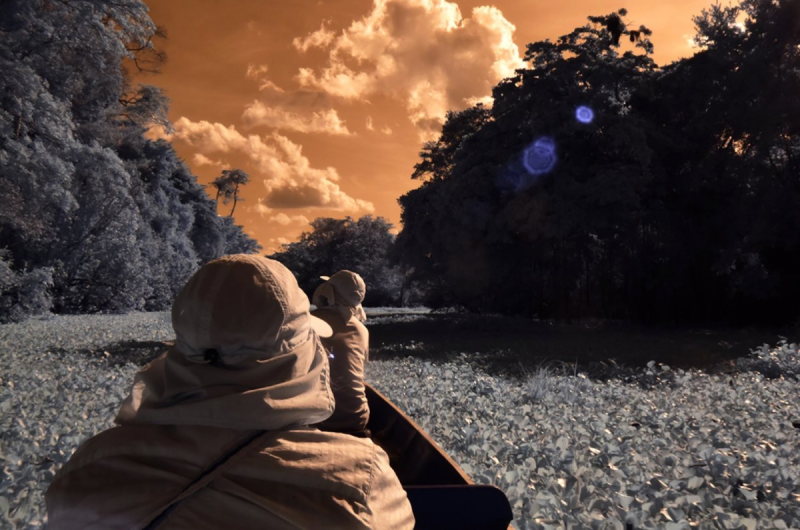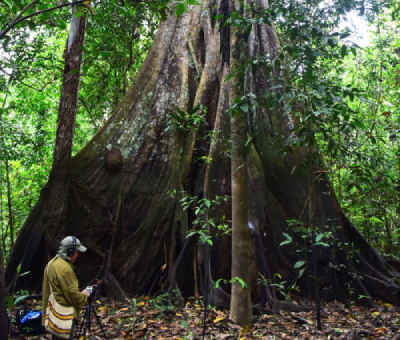Q&A: Opening the Boundaries Between Art and Science

Floating on a stream of water hyacinths, Yanayacu River/Amazon tributary, Loreto Region, Peru (infrared image)
Timothy Weaver, professor in DU’s Emergent Digital Practices program, recently spoke on the Scientific American Podcasts/Science Sound (E)scapes about his research and creative project involving ecoacoustics in the Amazon rainforest. The podcasts feature recordings of Amazonian pink river dolphins, nightly frog choruses and a canopy of woodpeckers and howler monkeys. You can find more about his research and creative project on his website. Weaver talked with us in more detail about his ecoacoustics research.
How does your work in Emergent Digital Practices and the School of Art & Art History come into contact with the biological sciences?
My creative research background is an art-science hybrid. Previous and tangential to my career as an artist, I was a microbial ecologist and bioenvironmental engineer for 15 years. I then chose to explore an alternate path to raising consciousness to environmental vulnerabilities through emergent creative expression (via sculptural/interactive installation and new media) rather than solely through scientific inquiry, invention and publication. I continue to rely on scientific rigor as the foundation of my creative research to move both science and art into synergized practice — where science advances art and art informs the logic of scientific intent.
How did you discover some of the creatures that you document in your sound recordings, such as the endangered pink river dolphin of the Amazonian rainforest?
My awareness of the biodiverse splendor of the Andean and Amazonian neotropics was awakened through the good fortune of my appointment as a Fulbright Research Scholar to Ecuador in the early 1990s. I was witnessing the impact of environmental changes on the richest biodiversity on the planet — and thus upon the traditional material culture/expression in the Andes and upper Amazon Basin. This splendor of biodiversity is the bedrock of the expansive human language and biocultural diversities of the region. Since then, I have been a lifelong Andean/Amazonian researcher in Ecuador, Bolivia, Peru and also in Brazil.
The Pink River Dolphin (or boto as it is called in Brazil) has been inherited as an iconic mythological being from the pre-conquest cultures of the Amazon. Its ecological survival has now become endangered with the erosion and forgetting of its importance as an indigenous biocultural icon.
How do your sound experiments help you understand ecological stability?
Sensory-interactive engagement deepens the understanding of our biology and reinforces profound visceral connections to common and distant lifeforms. When local birds do not sing nor migrate in their seasonal timeframe, feedback from our ecological memory alerts us that our biological space has been compromised (as in Rachel Carson’s “Silent Spring”). Raising environmental consciousness through bearing witness and creating new media testimonials to the complex beauty of the natural world are seeds for transformative experiences for public audiences. By coupling the greater public imaginary with the collective notions of the moments, conditions and residues of ecological memory can be empowered for environmental action.
Can you tell us about your experience of the Sharawadji effect or "psychoacoustics" when you were recording the nightly frog calls of the Amazon?
The Sharawadji effect is an aesthetic experience of aural sublime, catalyzed by the context of the listening experience in saturated environments such as the Amazon rainforest. It is the most rewarding experience of doing ecoacoustic research. The Sharawadji effect often results from the plentitude of natural soundscapes and is not exclusive to the Amazon. Sharawadji sounds belong to everyday life — so the effect could occur in one’s backyard or neighborhood park. The experience is driven by the psychoacoustic senses of each individual paired with the moment and context of listening. This is the encoding of ecological memory.
Where do you see the application of your research in non-academic environments?
The intent of this art-science work is to activate environmental consciousness towards the most vulnerable and exquisite biogems of our planet. But also to remind us that that ecological memory is critical to our orientation with the earth and our co-inhabitants. I hope to bridge a dialogue between art and science as an instance of emergent sensibilities into the endangered ecological memory of our imperiled planet. Every day we are on an ecological wander and a lifelong collective pilgrimage to encode ecological memory. This pilgrimage gives us the time and space to remember that we are the biosphere with the responsibility to preserve the environs around us.







